函数式编程-Stream流
实例练习:https://javadaily.cn/post/2022020817/7f222b3057fb/
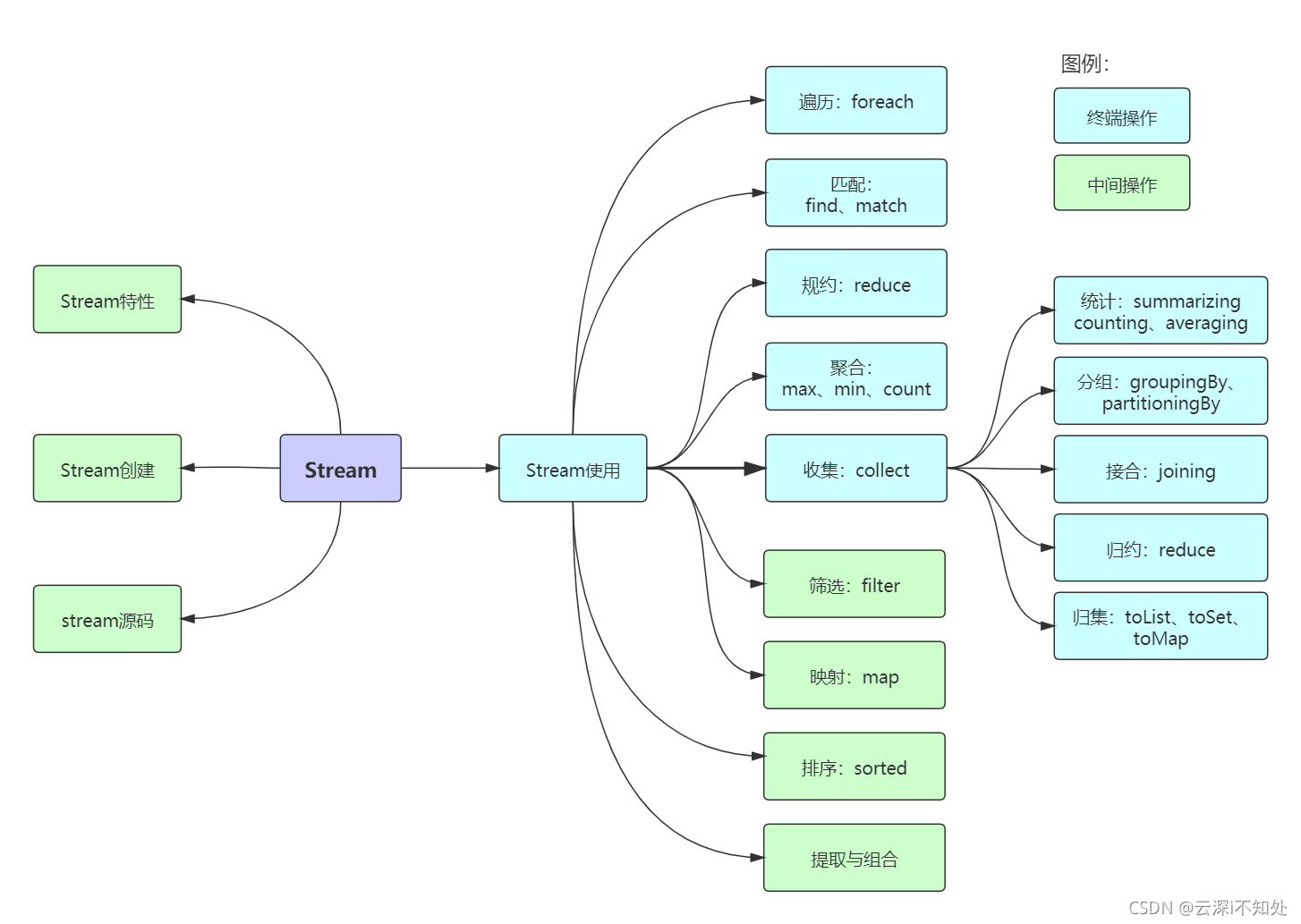
1. 概述
1.1 为什么学?
- 能够看懂公司里的代码
- 大数量下处理集合效率高
- 代码可读性高
- 消灭嵌套地狱
//查询未成年作家的评分在70以上的书籍 由于洋流影响所以作家和书籍可能出现重复,需要进行去重
List<Book> bookList = new ArrayList<>();
Set<Book> uniqueBookValues = new HashSet<>();
Set<Author> uniqueAuthorValues = new HashSet<>();
for (Author author : authors) {
if (uniqueAuthorValues.add(author)) {
if (author.getAge() < 18) {
List<Book> books = author.getBooks();
for (Book book : books) {
if (book.getScore() > 70) {
if (uniqueBookValues.add(book)) {
bookList.add(book);
}
}
}
}
}
}
System.out.println(bookList);
List<Book> collect = authors.stream()
.distinct()
.filter(author -> author.getAge() < 18)
.map(author -> author.getBooks())
.flatMap(Collection::stream)
.filter(book -> book.getScore() > 70)
.distinct()
.collect(Collectors.toList());
System.out.println(collect);
1.2 函数式编程思想
1.2.1 概念
面向对象思想需要关注用什么对象完成什么事情。而函数式编程思想就类似于我们数学中的函数。它主要关注的是对数据进行了什么操作。
1.2.2 优点
- 代码简洁,开发快速
- 接近自然语言,易于理解
- 易于"并发编程"
2. Lambda表达式
2.1 概述
Lambda是JDK8中一个语法糖。他可以对某些匿名内部类的写法进行简化。它是函数式编程思想的一个重要体现。让我们不用关注是什么对象。而是更关注我们对数据进行了什么操作。
2.2 核心原则
可推导可省略
2. 3 基本格式
(参数列表)->{代码}
例一
我们在创建线程并启动时可以使用匿名内部类的写法:
new Thread(new Runnable() {
@Override
public void run() {
System.out.println("你知道吗 我比你想象的 更想在你身边");
}
}).start();
可以使用Lambda的格式对其进行修改。修改后如下:
new Thread(()->{
System.out.println("你知道吗 我比你想象的 更想在你身边");
}).start();
例二:
现有方法定义如下,其中IntBinaryOperator是一个接口。先使用匿名内部类的写法调用该方法。
public static int calculateNum(IntBinaryOperator operator){
int a = 10;
int b = 20;
return operator.applyAsInt(a, b);
}
public static void main(String[] args) {
int i = calculateNum(new IntBinaryOperator() {
@Override
public int applyAsInt(int left, int right) {
return left + right;
}
});
System.out.println(i);
}
Lambda写法:
public static void main(String[] args) {
int i = calculateNum((int left, int right)->{
return left + right;
});
System.out.println(i);
}
例三:
现有方法定义如下,其中IntPredicate是一个接口。先使用匿名内部类的写法调用该方法。
public static void printNum(IntPredicate predicate){
int[] arr = {1,2,3,4,5,6,7,8,9,10};
for (int i : arr) {
if(predicate.test(i)){
System.out.println(i);
}
}
}
public static void main(String[] args) {
printNum(new IntPredicate() {
@Override
public boolean test(int value) {
return value%2==0;
}
});
}
Lambda写法:
public static void main(String[] args) {
printNum((int value)-> {
return value%2==0;
});
}
public static void printNum(IntPredicate predicate){
int[] arr = {1,2,3,4,5,6,7,8,9,10};
for (int i : arr) {
if(predicate.test(i)){
System.out.println(i);
}
}
}
例四:
现有方法定义如下,其中Function是一个接口。先使用匿名内部类的写法调用该方法。
public static <R> R typeConver(Function<String,R> function){
String str = "1235";
R result = function.apply(str);
return result;
}
public static void main(String[] args) {
Integer result = typeConver(new Function<String, Integer>() {
@Override
public Integer apply(String s) {
return Integer.valueOf(s);
}
});
System.out.println(result);
}
Lambda写法:
Integer result = typeConver((String s)->{
return Integer.valueOf(s);
});
System.out.println(result);
例五:
现有方法定义如下,其中IntConsumer是一个接口。先使用匿名内部类的写法调用该方法。
public static void foreachArr(IntConsumer consumer){
int[] arr = {1,2,3,4,5,6,7,8,9,10};
for (int i : arr) {
consumer.accept(i);
}
}
public static void main(String[] args) {
foreachArr(new IntConsumer() {
@Override
public void accept(int value) {
System.out.println(value);
}
});
}
Lambda写法:
public static void main(String[] args) {
foreachArr((int value)->{
System.out.println(value);
});
}
2.4 省略规则
- 参数类型可以省略
- 方法体只有一句代码时大括号return和唯一一句代码的分号可以省略
- 方法只有一个参数时小括号可以省略
- 以上这些规则都记不住也可以省略不记
3. Stream流入门
3.1 概述
Java8的Stream使用的是函数式编程模式,如同它的名字一样,它可以被用来对集合或数组进行链状流式的操作。可以更方便的让我们对集合或数组操作。
3.2 案例数据准备
<dependencies>
<dependency>
<groupId>org.projectlombok</groupId>
<artifactId>lombok</artifactId>
<version>1.18.16</version>
</dependency>
</dependencies>
@Data
@NoArgsConstructor
@AllArgsConstructor
@EqualsAndHashCode//用于后期的去重使用
public class Author {
//id
private Long id;
//姓名
private String name;
//年龄
private Integer age;
//简介
private String intro;
//作品
private List<Book> books;
}
@Data
@AllArgsConstructor
@NoArgsConstructor
@EqualsAndHashCode//用于后期的去重使用
public class Book {
//id
private Long id;
//书名
private String name;
//分类
private String category;
//评分
private Integer score;
//简介
private String intro;
}
private static List<Author> getAuthors() {
//数据初始化
Author author = new Author(1L,"蒙多",33,"一个从菜刀中明悟哲理的祖安人",null);
Author author2 = new Author(2L,"亚拉索",15,"狂风也追逐不上他的思考速度",null);
Author author3 = new Author(3L,"易",14,"是这个世界在限制他的思维",null);
Author author4 = new Author(3L,"易",14,"是这个世界在限制他的思维",null);
//书籍列表
List<Book> books1 = new ArrayList<>();
List<Book> books2 = new ArrayList<>();
List<Book> books3 = new ArrayList<>();
books1.add(new Book(1L,"刀的两侧是光明与黑暗","哲学,爱情",88,"用一把刀划分了爱恨"));
books1.add(new Book(2L,"一个人不能死在同一把刀下","个人成长,爱情",99,"讲述如何从失败中明悟真理"));
books2.add(new Book(3L,"那风吹不到的地方","哲学",85,"带你用思维去领略世界的尽头"));
books2.add(new Book(3L,"那风吹不到的地方","哲学",85,"带你用思维去领略世界的尽头"));
books2.add(new Book(4L,"吹或不吹","爱情,个人传记",56,"一个哲学家的恋爱观注定很难把他所在的时代理解"));
books3.add(new Book(5L,"你的剑就是我的剑","爱情",56,"无法想象一个武者能对他的伴侣这么的宽容"));
books3.add(new Book(6L,"风与剑","个人传记",100,"两个哲学家灵魂和肉体的碰撞会激起怎么样的火花呢?"));
books3.add(new Book(6L,"风与剑","个人传记",100,"两个哲学家灵魂和肉体的碰撞会激起怎么样的火花呢?"));
author.setBooks(books1);
author2.setBooks(books2);
author3.setBooks(books3);
author4.setBooks(books3);
List<Author> authorList = new ArrayList<>(Arrays.asList(author,author2,author3,author4));
return authorList;
}
使用到的员工类
List<Person> personList = new ArrayList<Person>();
personList.add(new Person("Tom", 8900, "male", "New York"));
personList.add(new Person("Jack", 7000, "male", "Washington"));
personList.add(new Person("Lily", 7800, "female", "Washington"));
personList.add(new Person("Anni", 8200, "female", "New York"));
personList.add(new Person("Owen", 9500, "male", "New York"));
personList.add(new Person("Alisa", 7900, "female", "New York"));
class Person {
private String name; // 姓名
private int salary; // 薪资
private int age; // 年龄
private String sex; //性别
private String area; // 地区
// 构造方法
public Person(String name, int salary, int age,String sex,String area) {
this.name = name;
this.salary = salary;
this.age = age;
this.sex = sex;
this.area = area;
}
// 省略了get和set,请自行添加
}
3.3 快速入门
3.3.1 需求
我们可以调用getAuthors方法获取到作家的集合。现在需要打印所有年龄小于18的作家的名字,并且要注意去重。
3.3.2 实现
//打印所有年龄小于18的作家的名字,并且要注意去重
List<Author> authors = getAuthors();
authors.
stream()//把集合转换成流
.distinct()//先去除重复的作家
.filter(author -> author.getAge()<18)//筛选年龄小于18的
.forEach(author -> System.out.println(author.getName()));//遍历打印名字
4. Stream常用操作(⭐)
4.1 创建流
单列集合
单列集合: 集合对象.stream()
List<Author> authors = getAuthors();
Stream<Author> stream = authors.stream();
数组
数组:Arrays.stream(数组) 或者使用Stream.of来创建
Integer[] arr = {1,2,3,4,5};
Stream<Integer> stream = Arrays.stream(arr);
Stream<Integer> stream2 = Stream.of(arr);
双列集合
双列集合:转换成单列集合后再创建
Map<String,Integer> map = new HashMap<>();
map.put("蜡笔小新",19);
map.put("黑子",17);
map.put("日向翔阳",16);
Stream<Map.Entry<String, Integer>> stream = map.entrySet().stream();
4.2 中间操作
filter
可以对流中的元素进行条件过滤,符合过滤条件的才能继续留在流中。
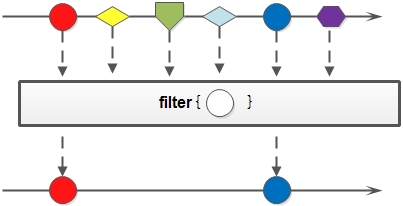
例如:
打印所有姓名长度大于1的作家的姓名
List<Author> authors = getAuthors();
authors.stream()
.filter(author -> author.getName().length()>1)
.forEach(author -> System.out.println(author.getName()));
map
可以把对流中的元素进行计算或转换。(可以把一个类转成另一个类)
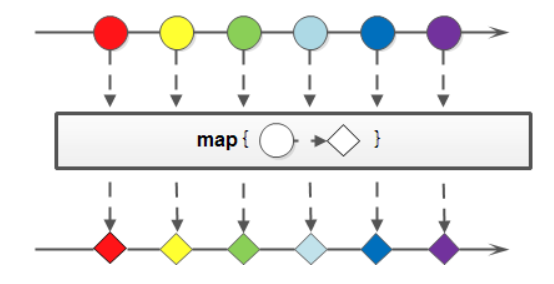
@Test
void mapTest(){
String[] strArr = { "abcd", "bcdd", "defde", "fTr" };
List<String> strList = Arrays.stream(strArr).map(String::toUpperCase).collect(Collectors.toList());
List<Integer> intList = Arrays.asList(1, 3, 5, 7, 9, 11);
List<Integer> intListNew = intList.stream().map(x -> x + 3).collect(Collectors.toList());
System.out.println("每个元素大写:" + strList);
System.out.println("每个元素+3:" + intListNew);
}
每个元素大写:[ABCD, BCDD, DEFDE, FTR]
每个元素+3:[4, 6, 8, 10, 12, 14]
例如:
打印所有作家的姓名
List<Author> authors = getAuthors();
authors.stream()
.map(author -> author.getName())
.forEach(name->System.out.println(name));
// 打印所有作家的姓名
List<Author> authors = getAuthors();
// authors.stream()
// .map(author -> author.getName())
// .forEach(s -> System.out.println(s));
authors.stream()
.map(author -> author.getAge())
.map(age->age+10)
.forEach(age-> System.out.println(age));
flatMap
map只能把一个对象转换成另一个对象来作为流中的元素。而flatMap可以把一个对象转换成多个对象作为流中的元素。

例一:
打印所有书籍的名字。要求对重复的元素进行去重。
// 打印所有书籍的名字。要求对重复的元素进行去重。
List<Author> authors = getAuthors();
authors.stream()
.flatMap(author -> author.getBooks().stream())
.distinct()
.forEach(book -> System.out.println(book.getName()));
例二:
打印现有数据的所有分类。要求对分类进行去重。不能出现这种格式:哲学,爱情
// 打印现有数据的所有分类。要求对分类进行去重。不能出现这种格式:哲学,爱情 爱情
List<Author> authors = getAuthors();
authors.stream()
.flatMap(author -> author.getBooks().stream())
.distinct()
.flatMap(book -> Arrays.stream(book.getCategory().split(",")))
.distinct()
.forEach(category-> System.out.println(category));
sorted
可以对流中的元素进行排序。
有两种排序:
- sorted():自然排序,流中元素需实现Comparable接口
- sorted(Comparator com):Comparator排序器自定义排序
例如:
对流中的元素按照年龄进行降序排序,并且要求不能有重复的元素。
// 对流中的元素按照年龄进行降序排序,并且要求不能有重复的元素。
@Test
void test10(){
List<Author> authors = getAuthors();
// 正常执行
authors.stream()
.distinct()
.sorted((o1, o2) -> o2.getAge()-o1.getAge())
.forEach(author -> System.out.println(author.getAge()));
// 没有实现Comparable方法,报错
authors.stream()
.distinct()
.sorted()
.forEach(author -> System.out.println(author.getAge()));
}
注意:如果调用空参的sorted()方法,需要流中的元素是实现了Comparable。
33
15
14
java.lang.ClassCastException: class com.example.stream_learn717.pojo.Author cannot be cast to class java.lang.Comparable (com.example.stream_learn717.pojo.Author is in unnamed module of loader 'app'; java.lang.Comparable is in module java.base of loader 'bootstrap')
at java.base/java.util.Comparators$NaturalOrderComparator.compare(Comparators.java:47)
at java.base/java.util.TimSort.countRunAndMakeAscending(TimSort.java:355)
at java.base/java.util.TimSort.sort(TimSort.java:220)
案例:将员工按工资由高到低(工资一样则按年龄由大到小)排序
@Test
void test9(){
List<Person> personList = new ArrayList<Person>();
personList.add(new Person("Sherry", 9000, 24, "female", "New York"));
personList.add(new Person("Tom", 8900, 22, "male", "Washington"));
personList.add(new Person("Jack", 9000, 25, "male", "Washington"));
personList.add(new Person("Lily", 8800, 26, "male", "New York"));
personList.add(new Person("Alisa", 9000, 26, "female", "New York"));
// 按工资升序排序(自然排序)
List<String> newList = personList.stream()
.sorted(Comparator.comparing(Person::getSalary))
.map(Person::getName)
.collect(Collectors.toList());
// 按工资倒序排序
List<String> newList2 = personList.stream()
.sorted(Comparator.comparing(Person::getSalary).reversed())
.map(Person::getName)
.collect(Collectors.toList());
// 先按工资再按年龄升序排序
List<String> newList3 = personList.stream()
.sorted(Comparator.comparing(Person::getSalary).thenComparing(Person::getAge))
.map(Person::getName)
.collect(Collectors.toList());
// 先按工资再按年龄自定义排序(降序)
List<String> newList4 = personList.stream().sorted((p1, p2) -> {
if (p1.getSalary() == p2.getSalary()) {
return p2.getAge() - p1.getAge();
} else {
return p2.getSalary() - p1.getSalary();
}
}).map(Person::getName).collect(Collectors.toList());
System.out.println("按工资升序排序:" + newList);
System.out.println("按工资降序排序:" + newList2);
System.out.println("先按工资再按年龄升序排序:" + newList3);
System.out.println("先按工资再按年龄自定义降序排序:" + newList4);
}
运行结果
按工资升序排序:[Lily, Tom, Sherry, Jack, Alisa]
按工资降序排序:[Sherry, Jack, Alisa, Tom, Lily]
先按工资再按年龄升序排序:[Lily, Tom, Sherry, Jack, Alisa]
先按工资再按年龄自定义降序排序:[Alisa, Jack, Sherry, Tom, Lily]
distinct
可以去除流中的重复元素。
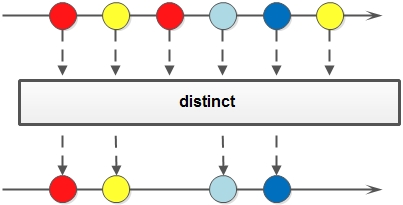
例如:
打印所有作家的姓名,并且要求其中不能有重复元素。
List<Author> authors = getAuthors();
authors.stream()
.distinct()
.forEach(author -> System.out.println(author.getName()));
注意:distinct方法是依赖Object的equals方法来判断是否是相同对象的。所以需要注意重写equals方法。
limit
可以设置流的最大长度,超出的部分将被抛弃。
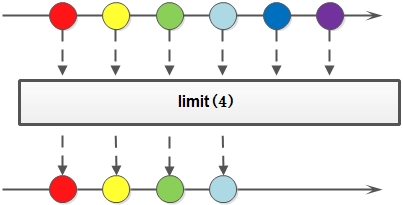
例如:
对流中的元素按照年龄进行降序排序,并且要求不能有重复的元素,然后打印其中年龄最大的两个作家的姓名。
List<Author> authors = getAuthors();
authors.stream()
.distinct()
.sorted()
.limit(2)
.forEach(author -> System.out.println(author.getName()));
skip
跳过流中的前n个元素,返回剩下的元素

例如:
打印除了年龄最大的作家外的其他作家,要求不能有重复元素,并且按照年龄降序排序。
// 打印除了年龄最大的作家外的其他作家,要求不能有重复元素,并且按照年龄降序排序。
List<Author> authors = getAuthors();
authors.stream()
.distinct()
.sorted()
.skip(1)
.forEach(author -> System.out.println(author.getName()));
peek
peek和foreach,都可以用于对元素进行遍历然后逐个的进行处理。
区别:
- peek属于中间方法,而foreach属于终止方法。
- 意味着peek只能作为管道中途的一个处理步骤,而没法直接执行得到结果,其后面必须还要有其它终止操作的时候才会被执行;
- 而foreach作为无返回值的终止方法,则可以直接执行相关操作。
@Test
void test12(){
List<Author> authors = getAuthors();
// 演示点1: 仅peek操作,最终不会执行
System.out.println("----before peek----");
authors.stream()
.peek(author -> System.out.println(author));
System.out.println("----after peek----" + "\n");
// 演示点2: 仅foreach操作,最终会执行
System.out.println("----before foreach----");
authors.stream()
.forEach(author -> System.out.println(author));
System.out.println("----after foreach----" + "\n");
// 演示点3: peek操作后面增加终止操作,peek会执行
System.out.println("----before peek and collect----");
List<Author> collect = authors.stream()
.peek(author -> System.out.println(author.getBooks()))
.collect(Collectors.toList());
System.out.println("----after peek and collect----" + "\n");
}
运行结果
输出结果可以看出,
peek独自调用时并没有被执行、但peek后面加上终止操作之后便可以被执行,而foreach可以直接被执行:
----before peek----
----after peek----
----before foreach----
Author(id=1, name=蒙多, age=33, intro=一个从菜刀中明悟哲理的祖安人, books=[Book(id=1, name=刀的两侧是光明与黑暗, category=哲学,爱情, score=88, intro=用一把刀划分了爱恨), Book(id=2, name=一个人不能死在同一把刀下, category=个人成长,爱情, score=99, intro=讲述如何从失败中明悟真理)])
Author(id=2, name=亚拉索, age=15, intro=狂风也追逐不上他的思考速度, books=[Book(id=3, name=那风吹不到的地方, category=哲学, score=85, intro=带你用思维去领略世界的尽头), Book(id=3, name=那风吹不到的地方, category=哲学, score=85, intro=带你用思维去领略世界的尽头), Book(id=4, name=吹或不吹, category=爱情,个人传记, score=56, intro=一个哲学家的恋爱观注定很难把他所在的时代理解)])
Author(id=3, name=易, age=14, intro=是这个世界在限制他的思维, books=[Book(id=5, name=你的剑就是我的剑, category=爱情, score=56, intro=无法想象一个武者能对他的伴侣这么的宽容), Book(id=6, name=风与剑, category=个人传记, score=100, intro=两个哲学家灵魂和肉体的碰撞会激起怎么样的火花呢?), Book(id=6, name=风与剑, category=个人传记, score=100, intro=两个哲学家灵魂和肉体的碰撞会激起怎么样的火花呢?)])
Author(id=3, name=易, age=14, intro=是这个世界在限制他的思维, books=[Book(id=5, name=你的剑就是我的剑, category=爱情, score=56, intro=无法想象一个武者能对他的伴侣这么的宽容), Book(id=6, name=风与剑, category=个人传记, score=100, intro=两个哲学家灵魂和肉体的碰撞会激起怎么样的火花呢?), Book(id=6, name=风与剑, category=个人传记, score=100, intro=两个哲学家灵魂和肉体的碰撞会激起怎么样的火花呢?)])
----after foreach----
----before peek and collect----
[Book(id=1, name=刀的两侧是光明与黑暗, category=哲学,爱情, score=88, intro=用一把刀划分了爱恨), Book(id=2, name=一个人不能死在同一把刀下, category=个人成长,爱情, score=99, intro=讲述如何从失败中明悟真理)]
[Book(id=3, name=那风吹不到的地方, category=哲学, score=85, intro=带你用思维去领略世界的尽头), Book(id=3, name=那风吹不到的地方, category=哲学, score=85, intro=带你用思维去领略世界的尽头), Book(id=4, name=吹或不吹, category=爱情,个人传记, score=56, intro=一个哲学家的恋爱观注定很难把他所在的时代理解)]
[Book(id=5, name=你的剑就是我的剑, category=爱情, score=56, intro=无法想象一个武者能对他的伴侣这么的宽容), Book(id=6, name=风与剑, category=个人传记, score=100, intro=两个哲学家灵魂和肉体的碰撞会激起怎么样的火花呢?), Book(id=6, name=风与剑, category=个人传记, score=100, intro=两个哲学家灵魂和肉体的碰撞会激起怎么样的火花呢?)]
[Book(id=5, name=你的剑就是我的剑, category=爱情, score=56, intro=无法想象一个武者能对他的伴侣这么的宽容), Book(id=6, name=风与剑, category=个人传记, score=100, intro=两个哲学家灵魂和肉体的碰撞会激起怎么样的火花呢?), Book(id=6, name=风与剑, category=个人传记, score=100, intro=两个哲学家灵魂和肉体的碰撞会激起怎么样的火花呢?)]
----after peek and collect----
4.3 终结操作
forEach
对流中的元素进行遍历操作,我们通过传入的参数去指定对遍历到的元素进行什么具体操作。
Stream也是支持类似集合的遍历和匹配元素的,只是Stream中的元素是以Optional类型存在的。Stream的遍历、匹配非常简单。
例子:
输出所有作家的名字
// 输出所有作家的名字
List<Author> authors = getAuthors();
authors.stream()
.map(author -> author.getName())
.distinct()
.forEach(name-> System.out.println(name));
count
可以用来获取当前流中元素的个数。
@Test
void countTest(){
List<Integer> list = Arrays.asList(7, 6, 4, 8, 2, 11, 9);
long count = list.stream().filter(x -> x > 6).count();
System.out.println("list中大于6的元素个数:" + count);
}
list中大于6的元素个数:4
例子:
打印这些作家的所出书籍的数目,注意删除重复元素。
// 打印这些作家的所出书籍的数目,注意删除重复元素。
List<Author> authors = getAuthors();
long count = authors.stream()
.flatMap(author -> author.getBooks().stream())
.distinct()
.count();
System.out.println(count);
max&min
可以用来或者流中的最值。
例子:
分别获取这些作家的所出书籍的最高分和最低分并打印。
// 分别获取这些作家的所出书籍的最高分和最低分并打印。
//Stream<Author> -> Stream<Book> ->Stream<Integer> ->求值
List<Author> authors = getAuthors();
Optional<Integer> max = authors.stream()
.flatMap(author -> author.getBooks().stream())
.map(book -> book.getScore())
.max((score1, score2) -> score1 - score2);
Optional<Integer> min = authors.stream()
.flatMap(author -> author.getBooks().stream())
.map(book -> book.getScore())
.min((score1, score2) -> score1 - score2);
System.out.println(max.get());
System.out.println(min.get());
@Test
void maxTest(){
List<String> list = Arrays.asList("adnm", "admmt", "pot", "xbangd", "weoujgsd");
Optional<String> max = list.stream().max(Comparator.comparing(String::length));
System.out.println("最长的字符串:" + max.get());
}
最长的字符串:weoujgsd
@Test
void maxTest(){
List<Integer> list = Arrays.asList(7, 6, 9, 4, 11, 6);
// 自然排序
Optional<Integer> max = list.stream().max(Integer::compareTo);
// 自定义排序
Optional<Integer> max2 = list.stream().max((o1, o2) -> o1.compareTo(o2));
System.out.println("自然排序的最大值:" + max.get());
System.out.println("自定义排序的最大值:" + max2.get());
}
自然排序的最大值:11
自定义排序的最大值:11
@Test
void maxTest(){
List<Person> personList = new ArrayList<Person>();
personList.add(new Person("Tom", 8900, 23, "male", "New York"));
personList.add(new Person("Jack", 7000, 25, "male", "Washington"));
personList.add(new Person("Lily", 7800, 21, "female", "Washington"));
personList.add(new Person("Anni", 8200, 24, "female", "New York"));
personList.add(new Person("Owen", 9500, 25, "male", "New York"));
personList.add(new Person("Alisa", 7900, 26, "female", "New York"));
Optional<Person> max = personList.stream().max(Comparator.comparingInt(Person::getSalary));
System.out.println("员工工资最大值:" + max.get().getSalary());
}
员工工资最大值:9500
collect
因为流不存储数据,那么在流中的数据完成处理后,需要将流中的数据重新归集到新的集合里。toList、toSet和toMap比较常用,另外还有toCollection、toConcurrentMap等复杂一些的用法。
- 简单点说,就是把当前流转换成一个集合。
-
collect主要依赖java.util.stream.Collectors类内置的静态方法。
例子:
获取一个存放所有作者名字的List集合。
// 获取一个存放所有作者名字的List集合。
List<Author> authors = getAuthors();
List<String> nameList = authors.stream()
.map(author -> author.getName())
.collect(Collectors.toList());
System.out.println(nameList);
获取一个所有书名的Set集合。
// 获取一个所有书名的Set集合。
List<Author> authors = getAuthors();
Set<Book> books = authors.stream()
.flatMap(author -> author.getBooks().stream())
.collect(Collectors.toSet());
System.out.println(books);
获取一个Map集合,map的key为作者名,value为List
// 获取一个Map集合,map的key为作者名,value为List<Book>
List<Author> authors = getAuthors();
Map<String, List<Book>> map = authors.stream()
.distinct()
.collect(Collectors.toMap(author -> author.getName(), author -> author.getBooks()));
System.out.println(map);
归集(toList/toSet/toMap)
因为流不存储数据,那么在流中的数据完成处理后,需要将流中的数据重新归集到新的集合里。
toList、toSet和toMap比较常用,另外还有toCollection、toConcurrentMap等复杂一些的用法。
下面用一个案例演示toList、toSet和toMap:
@Test
void test3(){
// 针对数组的操作
List<Integer> list = Arrays.asList(1, 6, 3, 4, 6, 7, 9, 6, 20);
List<Integer> listNew = list.stream()
.filter(x -> x % 2 == 0)
.collect(Collectors.toList());
Set<Integer> set = list.stream().filter(x -> x % 2 == 0).collect(Collectors.toSet());
// 针对对象集合的操作
List<Person> personList = new ArrayList<Person>();
personList.add(new Person("Tom", 8900, 23, "male", "New York"));
personList.add(new Person("Jack", 7000, 25, "male", "Washington"));
personList.add(new Person("Lily", 7800, 21, "female", "Washington"));
personList.add(new Person("Anni", 8200, 24, "female", "New York"));
Map<?, Person> map = personList.stream()
.filter(p -> p.getSalary() > 8000)
.collect(Collectors.toMap(Person::getName, p -> p));
System.out.println("toList:" + listNew);
System.out.println("toSet:" + set);
System.out.println("toMap:" + map);
}
运行结果
toList:[6, 4, 6, 6, 20]
toSet:[4, 20, 6]
toMap:{Tom=Person(name=Tom, salary=8900, age=23, sex=male, area=New York), Anni=Person(name=Anni, salary=8200, age=24, sex=female, area=New York)}
统计(count/averaging)
Collectors提供了一系列用于数据统计的静态方法:
- 计数:
count - 平均值:
averagingInt、averagingLong、averagingDouble - 最值:
maxBy、minBy - 求和:
summingInt、summingLong、summingDouble - 统计以上所有:
summarizingInt、summarizingLong、summarizingDouble
@Test
void test5(){
List<Person> personList = new ArrayList<Person>();
personList.add(new Person("Tom", 8900, 23, "male", "New York"));
personList.add(new Person("Jack", 7000, 25, "male", "Washington"));
personList.add(new Person("Lily", 7800, 21, "female", "Washington"));
// 求总数
Long count = personList.stream().collect(Collectors.counting());
// 求平均工资
Double average = personList.stream().collect(Collectors.averagingDouble(Person::getSalary));
// 求最高工资
Optional<Integer> max = personList.stream().map(Person::getSalary).collect(Collectors.maxBy(Integer::compare));
// 求工资之和
Integer sum = personList.stream().collect(Collectors.summingInt(Person::getSalary));
// 一次性统计所有信息
DoubleSummaryStatistics collect = personList.stream().collect(Collectors.summarizingDouble(Person::getSalary));
System.out.println("员工总数:" + count);
System.out.println("员工平均工资:" + average);
System.out.println("员工工资总和:" + sum);
System.out.println("员工工资所有统计:" + collect);
}
运行结果
员工总数:3
员工平均工资:7900.0
员工工资总和:23700
员工工资所有统计:DoubleSummaryStatistics{count=3, sum=23700.000000, min=7000.000000, average=7900.000000, max=8900.000000}
分组(partitioningBy/groupingBy)
- 分区:将
stream按条件分为两个Map,比如员工按薪资是否高于8000分为两部分。- 分组:将集合分为多个Map,比如员工按性别分组。有单级分组和多级分组。

@Test
void test6(){
List<Person> personList = new ArrayList<Person>();
personList.add(new Person("Tom", 8900, "male", "New York"));
personList.add(new Person("Jack", 7000, "male", "Washington"));
personList.add(new Person("Lily", 7800, "female", "Washington"));
personList.add(new Person("Anni", 8200, "female", "New York"));
personList.add(new Person("Owen", 9500, "male", "New York"));
personList.add(new Person("Alisa", 7900, "female", "New York"));
// 将员工按薪资是否高于8000分组
Map<Boolean, List<Person>> part = personList.stream()
.collect(Collectors.partitioningBy(x -> x.getSalary() > 8000));
// 将员工按性别分组
Map<String, List<Person>> group = personList.stream()
.collect(Collectors.groupingBy(Person::getSex));
// 将员工先按性别分组,再按地区分组
Map<String, Map<String, List<Person>>> group2 = personList.stream()
.collect(Collectors.groupingBy(Person::getSex, Collectors.groupingBy(Person::getArea)));
System.out.println("员工按薪资是否大于8000分组情况:" + part);
System.out.println("员工按性别分组情况:" + group);
System.out.println("员工按性别、地区:" + group2);
}
运行结果
员工按薪资是否大于8000分组情况:{false=[Person(name=Jack, salary=7000, age=0, sex=male, area=Washington), Person(name=Lily, salary=7800, age=0, sex=female, area=Washington), Person(name=Alisa, salary=7900, age=0, sex=female, area=New York)], true=[Person(name=Tom, salary=8900, age=0, sex=male, area=New York), Person(name=Anni, salary=8200, age=0, sex=female, area=New York), Person(name=Owen, salary=9500, age=0, sex=male, area=New York)]}
员工按性别分组情况:{female=[Person(name=Lily, salary=7800, age=0, sex=female, area=Washington), Person(name=Anni, salary=8200, age=0, sex=female, area=New York), Person(name=Alisa, salary=7900, age=0, sex=female, area=New York)], male=[Person(name=Tom, salary=8900, age=0, sex=male, area=New York), Person(name=Jack, salary=7000, age=0, sex=male, area=Washington), Person(name=Owen, salary=9500, age=0, sex=male, area=New York)]}
员工按性别、地区:{female={New York=[Person(name=Anni, salary=8200, age=0, sex=female, area=New York), Person(name=Alisa, salary=7900, age=0, sex=female, area=New York)], Washington=[Person(name=Lily, salary=7800, age=0, sex=female, area=Washington)]}, male={New York=[Person(name=Tom, salary=8900, age=0, sex=male, area=New York), Person(name=Owen, salary=9500, age=0, sex=male, area=New York)], Washington=[Person(name=Jack, salary=7000, age=0, sex=male, area=Washington)]}}
接合(joining)
joining可以将stream中的元素用特定的连接符(没有的话,则直接连接)连接成一个字符串。
@Test
void test7(){
List<Person> personList = new ArrayList<Person>();
personList.add(new Person("Tom", 8900, 23, "male", "New York"));
personList.add(new Person("Jack", 7000, 25, "male", "Washington"));
personList.add(new Person("Lily", 7800, 21, "female", "Washington"));
String names = personList.stream()
.map(p -> p.getName())
.collect(Collectors.joining(","));
System.out.println("所有员工的姓名:" + names);
List<String> list = Arrays.asList("A", "B", "C");
String string = list.stream()
.collect(Collectors.joining("-"));
System.out.println("拼接后的字符串:" + string);
}
运行结果
所有员工的姓名:Tom,Jack,Lily
拼接后的字符串:A-B-C
归约(reducing)
Collectors类提供的reducing方法,相比于stream本身的reduce方法,增加了对自定义归约的支持。
@Test
void test8(){
List<Person> personList = new ArrayList<Person>();
personList.add(new Person("Tom", 8900, 23, "male", "New York"));
personList.add(new Person("Jack", 7000, 25, "male", "Washington"));
personList.add(new Person("Lily", 7800, 21, "female", "Washington"));
// 每个员工减去起征点后的薪资之和
Integer sum = personList.stream()
// 使用的时候Collectors类提供的reducing方法
.collect(Collectors.reducing(0, Person::getSalary, (i, j) -> (i + j - 5000)));
System.out.println("员工扣税薪资总和:" + sum);
// stream的reduce
Optional<Integer> sum2 = personList.stream()
.map(Person::getSalary)
.reduce(Integer::sum);
System.out.println("员工薪资总和:" + sum2.get());
}
运行结果
员工扣税薪资总和:8700
员工薪资总和:23700
查找与匹配
Stream也是支持类似集合的遍历和匹配元素的,只是Stream中的元素是以Optional类型存在的。Stream的遍历、匹配非常简单。
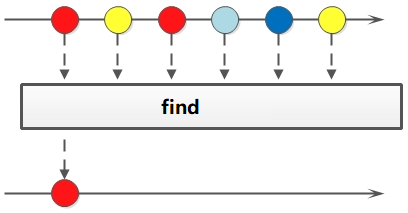
anyMatch
可以用来判断是否有任意符合匹配条件的元素,结果为boolean类型。
例子:
判断是否有年龄在29以上的作家
// 判断是否有年龄在29以上的作家
List<Author> authors = getAuthors();
boolean flag = authors.stream()
.anyMatch(author -> author.getAge() > 29);
System.out.println(flag);
allMatch
可以用来判断是否都符合匹配条件,结果为boolean类型。如果都符合结果为true,否则结果为false。
例子:
判断是否所有的作家都是成年人
// 判断是否所有的作家都是成年人
List<Author> authors = getAuthors();
boolean flag = authors.stream()
.allMatch(author -> author.getAge() >= 18);
System.out.println(flag);
noneMatch
可以判断流中的元素是否都不符合匹配条件。如果都不符合结果为true,否则结果为false
例子:
判断作家是否都没有超过100岁的。
// 判断作家是否都没有超过100岁的。
List<Author> authors = getAuthors();
boolean b = authors.stream()
.noneMatch(author -> author.getAge() > 100);
System.out.println(b);
findAny
获取流中的任意一个元素。该方法没有办法保证获取的一定是流中的第一个元素。
例子:
获取任意一个年龄大于18的作家,如果存在就输出他的名字
// 获取任意一个年龄大于18的作家,如果存在就输出他的名字
List<Author> authors = getAuthors();
Optional<Author> optionalAuthor = authors.stream()
.filter(author -> author.getAge()>18)
.findAny();
optionalAuthor.ifPresent(author -> System.out.println(author.getName()));
findFirst
获取流中的第一个元素。
例子:
获取一个年龄最小的作家,并输出他的姓名。
// 获取一个年龄最小的作家,并输出他的姓名。
List<Author> authors = getAuthors();
Optional<Author> first = authors.stream()
.sorted((o1, o2) -> o1.getAge() - o2.getAge())
.findFirst();
first.ifPresent(author -> System.out.println(author.getName()));
reduce归并

对流中的数据按照你指定的计算方式计算出一个结果。(缩减操作)
reduce的作用是把stream中的元素给组合起来,我们可以传入一个初始值,它会按照我们的计算方式依次拿流中的元素和初始化值进行计算,计算结果再和后面的元素计算。
(源码)reduce两个参数的重载形式内部的计算方式如下:
T result = identity;
for (T element : this stream)
result = accumulator.apply(result, element)
return result;
其中identity就是我们可以通过方法参数传入的初始值,accumulator的apply具体进行什么计算也是我们通过方法参数来确定的。
案例一:求Integer集合的元素之和、乘积和最大值。
@Test
void reduceTest(){
List<Integer> list = Arrays.asList(1, 3, 2, 8, 11, 4);
// 求和方式1
Optional<Integer> sum = list.stream().reduce((x, y) -> x + y);
// 求和方式2
Optional<Integer> sum2 = list.stream().reduce(Integer::sum);
// 求和方式3
Integer sum3 = list.stream().reduce(0, Integer::sum);
// 求乘积
Optional<Integer> product = list.stream().reduce( (x, y) -> x * y);
Integer reduce = list.stream().reduce(0, (x, y) -> x * y);
// 求最大值方式1
Optional<Integer> max = list.stream().reduce((x, y) -> x > y ? x : y);
// 求最大值写法2
Integer max2 = list.stream().reduce(1, (a, b) -> Integer.max(a, b));
System.out.println("list求和:" + sum.get() + "," + sum2.get() + "," + sum3);
System.out.println("list求积:" + product.get());
System.out.println("list求积:" + reduce);
System.out.println("list求和:" + max.get() + "," + max2);
}
list求和:29,29,29
list求积:2112
list求积:0
list求和:11,11
例子:
使用reduce求所有作者年龄的和
// 使用reduce求所有作者年龄的和
List<Author> authors = getAuthors();
Integer sum = authors.stream()
.distinct()
.map(author -> author.getAge())
.reduce(0, (result, element) -> result + element);
System.out.println(sum);
使用reduce求所有作者中年龄的最大值
// 使用reduce求所有作者中年龄的最大值
List<Author> authors = getAuthors();
Integer max = authors.stream()
.map(author -> author.getAge())
.reduce(Integer.MIN_VALUE, (result, element) -> result < element ? element : result);
System.out.println(max);
使用reduce求所有作者中年龄的最小值
// 使用reduce求所有作者中年龄的最小值
List<Author> authors = getAuthors();
Integer min = authors.stream()
.map(author -> author.getAge())
.reduce(Integer.MAX_VALUE, (result, element) -> result > element ? element : result);
System.out.println(min);
reduce一个参数的重载形式内部的计算
boolean foundAny = false;
T result = null;
for (T element : this stream) {
if (!foundAny) {
foundAny = true;
result = element;
}
else
result = accumulator.apply(result, element);
}
return foundAny ? Optional.of(result) : Optional.empty();
如果用一个参数的重载方法去求最小值代码如下:
// 使用reduce求所有作者中年龄的最小值
List<Author> authors = getAuthors();
Optional<Integer> minOptional = authors.stream()
.map(author -> author.getAge())
.reduce((result, element) -> result > element ? element : result);
minOptional.ifPresent(age-> System.out.println(age));
案例二:求所有员工的工资之和和最高工资。
@Test
void reduceTest(){
List<Person> personList = new ArrayList<Person>();
personList.add(new Person("Tom", 8900, 23, "male", "New York"));
personList.add(new Person("Jack", 7000, 25, "male", "Washington"));
personList.add(new Person("Lily", 7800, 21, "female", "Washington"));
personList.add(new Person("Anni", 8200, 24, "female", "New York"));
personList.add(new Person("Owen", 9500, 25, "male", "New York"));
personList.add(new Person("Alisa", 7900, 26, "female", "New York"));
// 求工资之和方式1:
Optional<Integer> sumSalary = personList.stream().map(Person::getSalary).reduce(Integer::sum);
// 求工资之和方式2:
Integer sumSalary2 = personList.stream().reduce(0, (sum, p) -> sum += p.getSalary(),
(sum1, sum2) -> sum1 + sum2);
// 求工资之和方式3:
Integer sumSalary3 = personList.stream().reduce(0, (sum, p) -> sum += p.getSalary(), Integer::sum);
// 求最高工资方式1:
Integer maxSalary = personList.stream().reduce(0, (max, p) -> max > p.getSalary() ? max : p.getSalary(),
Integer::max);
// 求最高工资方式2:
Integer maxSalary2 = personList.stream().reduce(0, (max, p) -> max > p.getSalary() ? max : p.getSalary(),
(max1, max2) -> max1 > max2 ? max1 : max2);
System.out.println("工资之和:" + sumSalary.get() + "," + sumSalary2 + "," + sumSalary3);
System.out.println("最高工资:" + maxSalary + "," + maxSalary2);
}
工资之和:49300,49300,49300
最高工资:9500,9500
4.4 注意事项
- 惰性求值(如果没有终结操作,没有中间操作是不会得到执行的)
- 流是一次性的(一旦一个流对象经过一个终结操作后。这个流就不能再被使用)
- 不会影响原数据(我们在流中可以多数据做很多处理。但是正常情况下是不会影响原来集合中的元素的。这往往也是我们期望的)
5. Optional(⭐)
5.1 概述
我们在编写代码的时候出现最多的就是空指针异常。所以在很多情况下我们需要做各种非空的判断。
例如:
Author author = getAuthor();
if(author!=null){
System.out.println(author.getName());
}
尤其是对象中的属性还是一个对象的情况下。这种判断会更多。
而过多的判断语句会让我们的代码显得臃肿不堪。
所以在JDK8中引入了Optional,养成使用Optional的习惯后你可以写出更优雅的代码来避免空指针异常。
并且在很多函数式编程相关的API中也都用到了Optional,如果不会使用Optional也会对函数式编程的学习造成影响。
5.2 使用
https://javadaily.cn/post/2022033125/ae75440d6afa/
5.2.1 创建对象
Optional就好像是包装类,可以把我们的具体数据封装Optional对象内部。然后我们去使用Optional中封装好的方法操作封装进去的数据就可以非常优雅的避免空指针异常。
我们一般使用Optional的静态方法ofNullable来把数据封装成一个Optional对象。无论传入的参数是否为null都不会出现问题。
Author author = getAuthor();
Optional<Author> authorOptional = Optional.ofNullable(author);
你可能会觉得还要加一行代码来封装数据比较麻烦。但是如果改造下getAuthor方法,让其的返回值就是封装好的Optional的话,我们在使用时就会方便很多。
而且在实际开发中我们的数据很多是从数据库获取的。Mybatis从3.5版本可以也已经支持Optional了。我们可以直接把dao方法的返回值类型定义成Optional类型,MyBastis会自己把数据封装成Optional对象返回。封装的过程也不需要我们自己操作。
如果你确定一个对象不是空的则可以使用Optional的静态方法of来把数据封装成Optional对象。
Author author = new Author();
Optional<Author> authorOptional = Optional.of(author);
但是一定要注意,如果使用of的时候传入的参数必须不为null。(尝试下传入null会出现什么结果)
如果一个方法的返回值类型是Optional类型。而如果我们经判断发现某次计算得到的返回值为null,这个时候就需要把null封装成Optional对象返回。这时则可以使用Optional的静态方法empty来进行封装。
Optional.empty()
所以最后你觉得哪种方式会更方便呢?ofNullable
5.2.2 安全消费值
我们获取到一个Optional对象后肯定需要对其中的数据进行使用。这时候我们可以使用其ifPresent方法对来消费其中的值。
这个方法会判断其内封装的数据是否为空,不为空时才会执行具体的消费代码。这样使用起来就更加安全了。
例如**,以下写法就优雅的避免了空指针异常**。
Optional<Author> authorOptional = Optional.ofNullable(getAuthor());
authorOptional.ifPresent(author -> System.out.println(author.getName()));
5.2.3 获取值
如果我们想获取值自己进行处理可以使用get()方法获取,但是不推荐。因为当Optional内部的数据为空的时候会出现异常。
5.2.4 安全获取值orElseGet
如果我们期望安全的获取值。我们不推荐使用get方法,而是使用Optional提供的以下方法。
orElseGet
-
orElseGet
获取数据并且设置数据为空时的默认值。如果数据不为空就能获取到该数据。如果为空则根据你传入的参数来创建对象作为默认值返回。
Optional<Author> authorOptional = Optional.ofNullable(getAuthor()); Author author1 = authorOptional.orElseGet(() -> new Author());
orElseThrow
-
orElseThrow
获取数据,如果数据不为空就能获取到该数据。如果为空则根据你传入的参数来创建异常抛出。
Optional<Author> authorOptional = Optional.ofNullable(getAuthor()); try { Author author = authorOptional.orElseThrow((Supplier<Throwable>) () -> new RuntimeException("author为空")); System.out.println(author.getName()); } catch (Throwable throwable) { throwable.printStackTrace(); }
5.2.5 过滤filter
我们可以使用filter方法对数据进行过滤。如果原本是有数据的,但是不符合判断,也会变成一个无数据的Optional对象。
Optional<Author> authorOptional = Optional.ofNullable(getAuthor());
authorOptional.filter(author -> author.getAge()>100).ifPresent(author -> System.out.println(author.getName()));
5.2.6 判断isPresent
我们可以使用isPresent方法进行是否存在数据的判断。如果为空返回值为false,如果不为空,返回值为true。但是这种方式并不能体现Optional的好处,更推荐使用ifPresent方法。
Optional<Author> authorOptional = Optional.ofNullable(getAuthor());
if (authorOptional.isPresent()) {
System.out.println(authorOptional.get().getName());
}
5.2.7 数据转换
Optional还提供了map可以让我们的对数据进行转换,并且转换得到的数据也还是被Optional包装好的,保证了我们的使用安全。
例如我们想获取作家的书籍集合。
private static void testMap() {
Optional<Author> authorOptional = getAuthorOptional();
Optional<List<Book>> optionalBooks = authorOptional.map(author -> author.getBooks());
optionalBooks.ifPresent(books -> System.out.println(books));
}
6. 函数式接口(⭐)
6.1 概述
只有一个抽象方法的接口我们称之为函数接口。
JDK的函数式接口都加上了**@FunctionalInterface** 注解进行标识。但是无论是否加上该注解只要接口中只有一个抽象方法,都是函数式接口。
Lambda就是Java中函数式编程的体现,可以使用Lambda表达式创建一个函数式接口的对象,一定要确保接口中有且只有一个抽象方法,这样Lambda才能顺利的进行推导。
6.2 常见函数式接口
1️⃣ Consumer 消费型接口
-
Consumer 消费接口
根据其中抽象方法的参数列表和返回值类型知道,我们可以在方法中对传入的参数进行消费。
抽象方法: void accept(T t),接收一个参数进行消费,但无需返回结果。
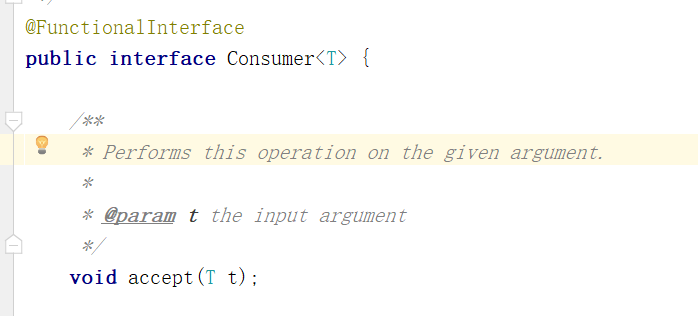
默认方法:
- andThen(Consumer<? super T> after),先消费然后在消费,先执行调用andThen接口的accept方法,然后在执行andThen方法参数after中的accept方法。
2️⃣ Function 函数型接口
-
Function 计算转换接口
根据其中抽象方法的参数列表和返回值类型知道,我们可以在方法中对传入的参数计算或转换,把结果返回
抽象方法: R apply(T t),传入一个参数T,返回想要的结果R。
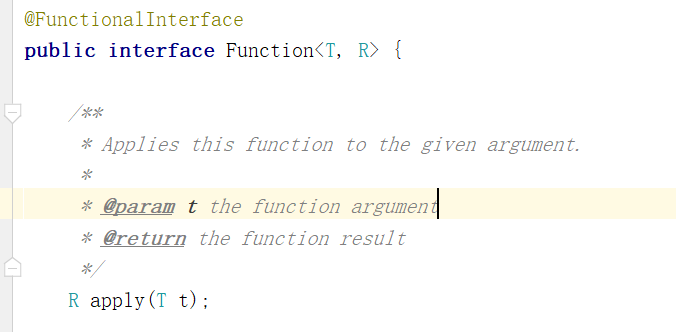
默认方法:-
**compose(Function<? super V, ? extends T> before),**先执行compose方法参数before中的apply方法,然后将执行结果传递给调用compose函数中的apply方法在执行。
-
andThen(Function<? super R, ? extends V> after),先执行调用andThen函数的apply方法,然后在将执行结果传递给andThen方法after参数中的apply方法在执行。它和compose方法整好是相反的执行顺序。
List<Author> authors = getAuthors(); Stream<Author> authorStream = authors.stream(); // 获取每个作家的著作集,然后选第一本作为book authorStream.map(new Function<Author, List<Book>>() { // 这里Author是传入参数类型T, List<Book>是返回的数据类型R @Override public List<Book> apply(Author author) { return author.getBooks(); } }.andThen(new Function<List<Book>, String>() { // 这里List<Book>是传入参数类型T,String是返回的参数类型R @Override public String apply(List<Book> books) { return books.get(0).getName(); } })).forEach(name -> System.out.println(name));运行结果
刀的两侧是光明与黑暗 那风吹不到的地方 你的剑就是我的剑 你的剑就是我的剑
-
3️⃣ Predicate 断言型接口
-
Predicate 判断接口
根据其中抽象方法的参数列表和返回值类型知道,我们可以在方法中对传入的参数条件判断,返回判断结果
抽象方法: boolean test(T t),传入一个参数,返回一个布尔值。
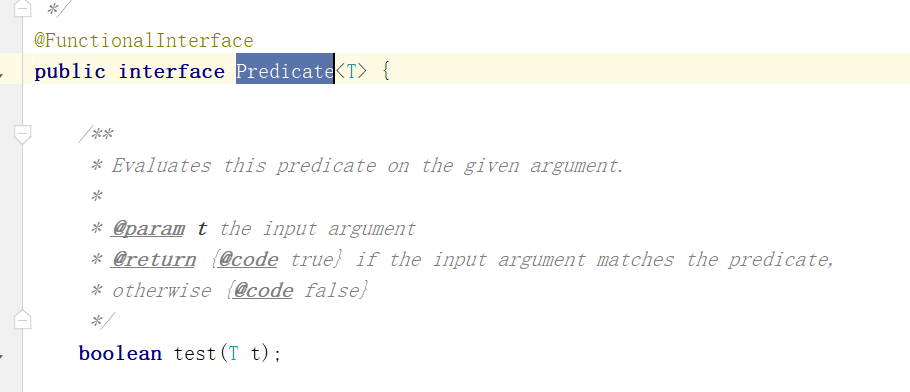
默认方法:
- and(Predicate<? super T> other),相当于逻辑运算符中的&&,当两个Predicate函数的返回结果都为true时才返回true。
- or(Predicate<? super T> other) ,相当于逻辑运算符中的||,当两个Predicate函数的返回结果有一个为true则返回true,否则返回false。
- negate(),这个方法的意思就是取反。
4️⃣ Supplier 生产型接口
-
Supplier 生产型接口
根据其中抽象方法的参数列表和返回值类型知道,我们可以在方法中创建对象,把创建好的对象返回
抽象方法:T get(),无参数,有返回值。
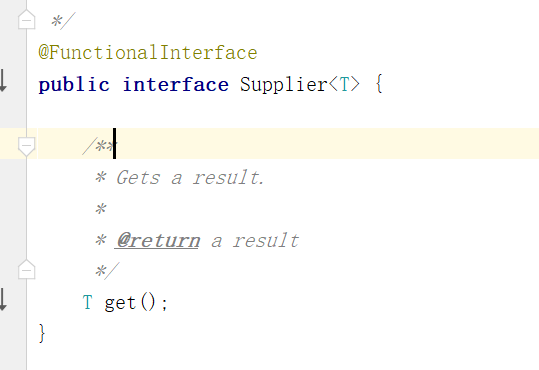
这类接口适合提供数据的场景。
其他函数式接口
Bi类型接口
BiConsumer、BiFunction、BiPrediate 是 Consumer、Function、Predicate 的扩展,可以传入多个参数,没有 BiSupplier 是因为 Supplier 没有入参。
操作基本数据类型的接口
IntConsumer、IntFunction、IntPredicate、IntSupplier、LongConsumer、LongFunction、LongPredicate、LongSupplier、Do ubleConsumer、DoubleFunction、DoublePredicate、DoubleSupplier。 其实常用的函数式接口就那四大接口Consumer、Function、Prediate、Supplier,其他的函数式接口就不一一列举了,有兴趣的可以去java.util.function这个包下详细的看。
7. 常用的默认方法
主要是Predicate函数式接口的方法用的比较多
and
-
and
我们在使用Predicate接口时候可能需要进行判断条件的拼接。而and方法相当于是使用&&来拼接两个判断条件
例如:
打印作家中年龄大于17并且姓名的长度大于1的作家。
List<Author> authors = getAuthors(); Stream<Author> authorStream = authors.stream(); authorStream.filter(new Predicate<Author>() { @Override public boolean test(Author author) { return author.getAge()>17; } }.and(new Predicate<Author>() { @Override public boolean test(Author author) { return author.getName().length()>1; } })).forEach(author -> System.out.println(author));
or
-
or
我们在使用Predicate接口时候可能需要进行判断条件的拼接。而or方法相当于是使用||来拼接两个判断条件。
例如:
打印作家中年龄大于17或者姓名的长度小于2的作家。
// 打印作家中年龄大于17或者姓名的长度小于2的作家。 List<Author> authors = getAuthors(); authors.stream() .filter(new Predicate<Author>() { @Override public boolean test(Author author) { return author.getAge()>17; } }.or(new Predicate<Author>() { @Override public boolean test(Author author) { return author.getName().length()<2; } })).forEach(author -> System.out.println(author.getName()));
negate
-
negate
Predicate接口中的方法。negate方法相当于是在判断添加前面加了个! 表示取反
例如:
打印作家中年龄不大于17的作家。
// 打印作家中年龄不大于17的作家。 List<Author> authors = getAuthors(); authors.stream() .filter(new Predicate<Author>() { @Override public boolean test(Author author) { return author.getAge()>17; } }.negate()).forEach(author -> System.out.println(author.getAge()));
8. 方法引用(初学不用太关注)
我们在使用lambda时,如果方法体中只有一个方法的调用的话(包括构造方法),我们可以用方法引用进一步简化代码。
8.1 推荐用法
我们在使用lambda时不需要考虑什么时候用方法引用,用哪种方法引用,方法引用的格式是什么。我们只需要在写完lambda方法发现方法体只有一行代码,并且是方法的调用时使用快捷键尝试是否能够转换成方法引用即可。
当我们方法引用使用的多了慢慢的也可以直接写出方法引用。
8.2 基本格式
类名或者对象名::方法名
8.3 语法详解(了解)
8.3.1 引用类的静态方法
其实就是引用类的静态方法
格式
类名::方法名
使用前提
如果我们在重写方法的时候,方法体中只有一行代码,并且这行代码是调用了某个类的静态方法,并且我们把要重写的,抽象方法中所有的参数都按照顺序传入了这个静态方法中,这个时候我们就可以引用类的静态方法。
例如:
如下代码就可以用方法引用进行简化
List<Author> authors = getAuthors();
Stream<Author> authorStream = authors.stream();
authorStream.map(author -> author.getAge())
.map(age->String.valueOf(age));
注意,如果我们所重写的方法是没有参数的,调用的方法也是没有参数的也相当于符合以上规则。
优化后如下:
List<Author> authors = getAuthors();
Stream<Author> authorStream = authors.stream();
authorStream.map(author -> author.getAge())
.map(String::valueOf);
8.3.2 引用对象的实例方法
格式
对象名::方法名
使用前提
如果我们在重写方法的时候,方法体中只有一行代码,并且这行代码是调用了某个对象的成员方法,并且我们把要重写的抽象方法中所有的参数都按照顺序传入了这个成员方法中,这个时候我们就可以引用对象的实例方法
例如:
List<Author> authors = getAuthors();
Stream<Author> authorStream = authors.stream();
StringBuilder sb = new StringBuilder();
authorStream.map(author -> author.getName())
.forEach(name->sb.append(name));
优化后:
List<Author> authors = getAuthors();
Stream<Author> authorStream = authors.stream();
StringBuilder sb = new StringBuilder();
authorStream.map(author -> author.getName())
.forEach(sb::append);
8.3.3 引用类的实例方法
格式
类名::方法名
使用前提
如果我们在重写方法的时候,方法体中只有一行代码,并且这行代码是调用了第一个参数的成员方法,并且我们把要重写的抽象方法中剩余的所有的参数都按照顺序传入了这个成员方法中,这个时候我们就可以引用类的实例方法。
例如:
interface UseString{
String use(String str,int start,int length);
}
public static String subAuthorName(String str, UseString useString){
int start = 0;
int length = 1;
return useString.use(str,start,length);
}
public static void main(String[] args) {
subAuthorName("三更草堂", new UseString() {
@Override
public String use(String str, int start, int length) {
return str.substring(start,length);
}
});
}
优化后如下:
public static void main(String[] args) {
subAuthorName("三更草堂", String::substring);
}
8.3.4 构造器引用
如果方法体中的一行代码是构造器的话就可以使用构造器引用。
格式
类名::new
使用前提
如果我们在重写方法的时候,方法体中只有一行代码,并且这行代码是调用了某个类的构造方法,并且我们把要重写的抽象方法中的所有的参数都按照顺序传入了这个构造方法中,这个时候我们就可以引用构造器。
例如:
List<Author> authors = getAuthors();
authors.stream()
.map(author -> author.getName())
.map(name->new StringBuilder(name))
.map(sb->sb.append("-三更").toString())
.forEach(str-> System.out.println(str));
优化后:
List<Author> authors = getAuthors();
authors.stream()
.map(author -> author.getName())
.map(StringBuilder::new)
.map(sb->sb.append("-三更").toString())
.forEach(str-> System.out.println(str));
9. Stream基本数据类型优化(⭐)
我们之前用到的很多Stream的方法由于都使用了泛型。所以涉及到的参数和返回值都是引用数据类型。
**即使我们操作的是整数小数,但是实际用的都是他们的包装类。(都是引用数据类型)**JDK5中引入的自动装箱和自动拆箱让我们在使用对应的包装类时就好像使用基本数据类型一样方便。但是你一定要知道装箱和拆箱肯定是要消耗时间的。虽然这个时间消耗很小。但是在大量的数据不断的重复装箱拆箱的时候,你就不能无视这个时间损耗了。
所以为了让我们能够对这部分的时间消耗进行优化。Stream还提供了很多专门针对基本数据类型的方法。
例如:mapToInt,mapToLong,mapToDouble,flatMapToInt,flatMapToDouble等。
private static void test27() {
List<Author> authors = getAuthors();
authors.stream()
.map(author -> author.getAge())
.map(age -> age + 10)
.filter(age->age>18)
.map(age->age+2)
.forEach(System.out::println);
// 使用mapToInt讲对象的年龄属性转换成整形
authors.stream()
.mapToInt(author -> author.getAge())
.map(age -> age + 10)
.filter(age->age>18)
.map(age->age+2)
.forEach(System.out::println);
}
10. 并行流(⭐)
**当流中有大量元素时,我们可以使用并行流去提高操作的效率。其实并行流就是把任务分配给多个线程去完全。**如果我们自己去用代码实现的话其实会非常的复杂,并且要求你对并发编程有足够的理解和认识。而如果我们使用Stream的话,我们只需要修改一个方法的调用就可以使用并行流来帮我们实现,从而提高效率。
机制:
使用并行流,可以有效利用计算机的多CPU硬件,提升逻辑的执行速度。并行流通过将一整个stream划分为
多个片段,然后对各个分片流并行执行处理逻辑,最后将各个分片流的执行结果汇总为一个整体流。
注意点和约束:
并行流类似于多线程在并行处理,所以与多线程场景相关的一些问题同样会存在,比如死锁等问题,所以在并行流终止执行的函数逻辑,必须要保证线程安全。
parallel方法可以把串行流转换成并行流。
private static void test28() {
Stream<Integer> stream = Stream.of(1, 2, 3, 4, 5, 6, 7, 8, 9, 10);
Integer sum = stream.parallel()
.peek(new Consumer<Integer>() {
@Override
public void accept(Integer num) {
System.out.println(num + Thread.currentThread().getName());
}
})
.filter(num -> num > 5)
.reduce((result, ele) -> result + ele)
.get();
System.out.println(sum);
}
也可以通过parallelStream直接获取并行流对象。
List<Author> authors = getAuthors();
authors.parallelStream()
.map(author -> author.getAge())
.map(age -> age + 10)
.filter(age->age>18)
.map(age->age+2)
.forEach(System.out::println);

























 214
214











 被折叠的 条评论
为什么被折叠?
被折叠的 条评论
为什么被折叠?








